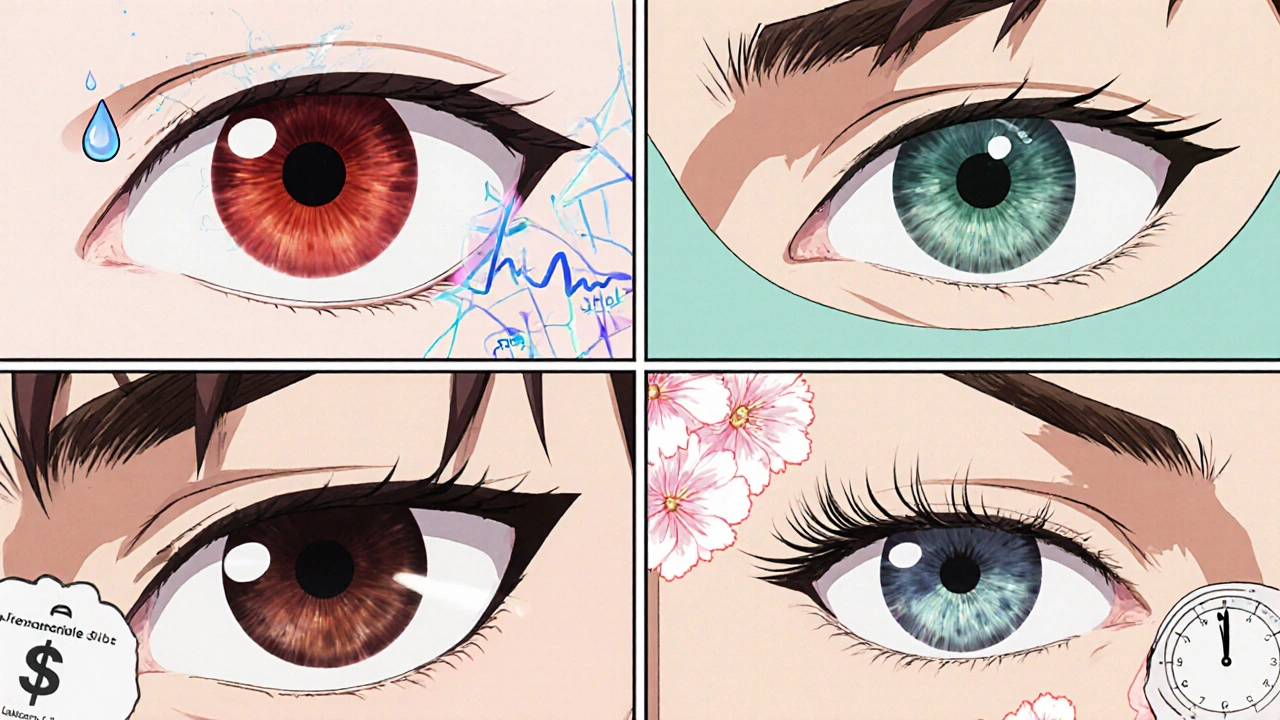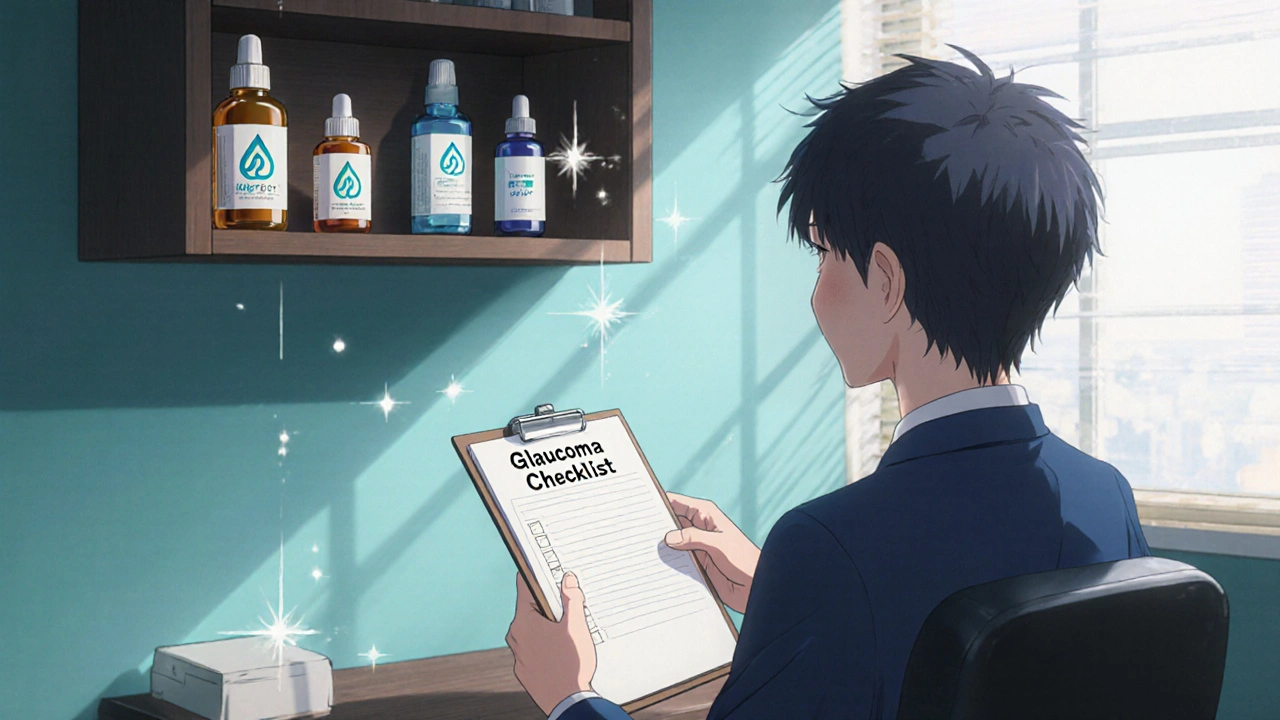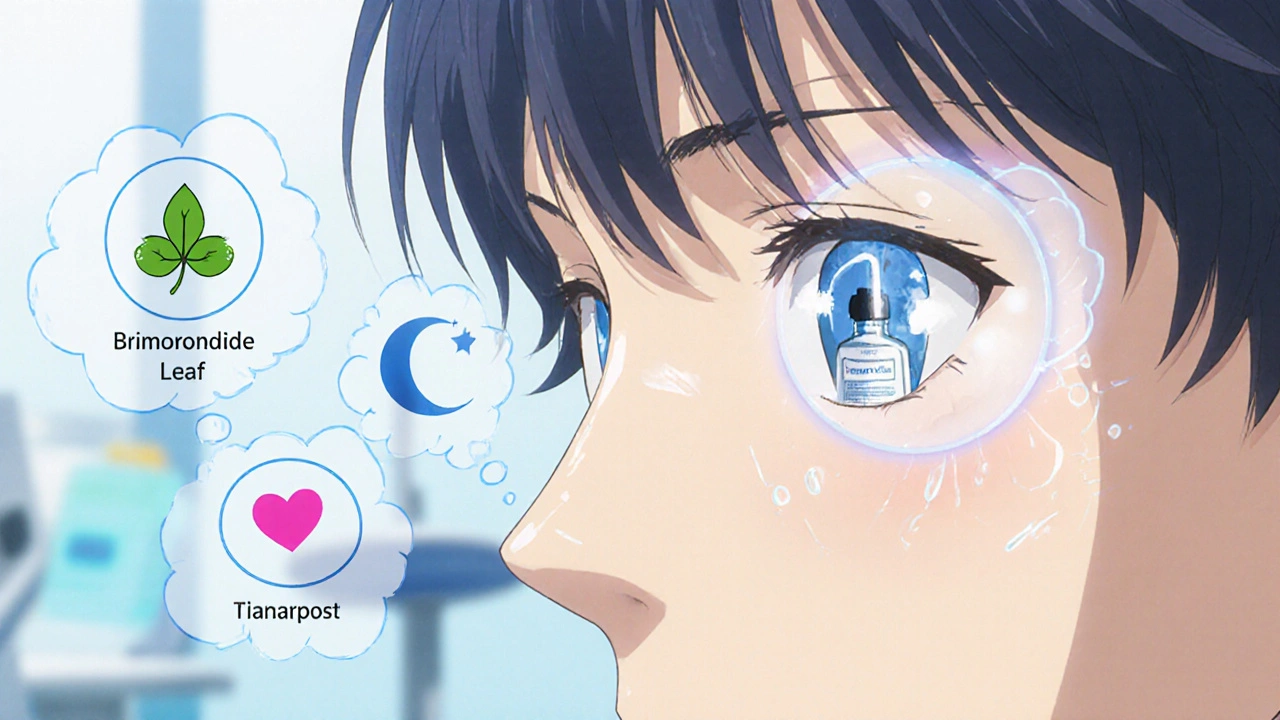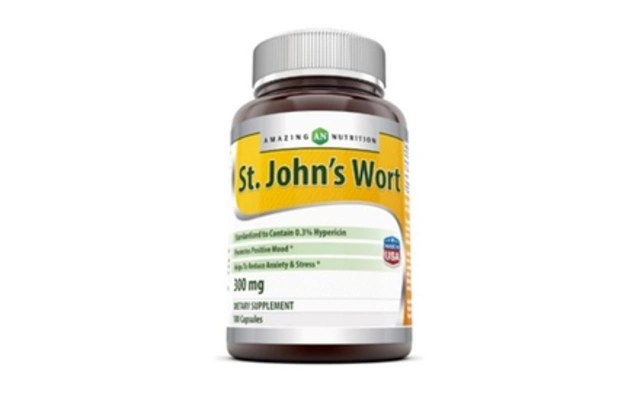Glaucoma Treatment Selector
Find Your Best Glaucoma Treatment Alternative
Answer a few questions about your medical history and preferences to see which glaucoma treatments might work best for you.
Your Medical Profile
Your Recommended Alternatives
Important: Always consult your eye doctor before making any changes to your glaucoma treatment. This tool is for informational purposes only and does not replace professional medical advice.
Quick Summary
- Not everyone tolerates Dorzolamide; common side effects include stinging, bitter taste, and rare allergic reactions.
- Alpha‑2 agonists, beta blockers, prostaglandin analogues, and miotics are the main drug families that can replace Dorzolamide.
- Choosing the right drop depends on your eye pressure goals, existing health conditions, and how often you want to dose.
- Combination drops can simplify regimens and lower costs.
- Talk to your eye doctor about any switch - they’ll weigh efficacy, safety, and insurance coverage.
When you’ve been using Dorzolamide a carbonic anhydrase inhibitor eye drop that reduces intraocular pressure for glaucoma, it feels like you’ve found a reliable routine. But irritation, cost, or a new diagnosis can make you wonder, “Are there other drops that work just as well?” This guide walks through the most common alternatives, why they might suit you better, and how to pick the right one.
What Is Dorzolamide and How Does It Work?
Dorzolamide belongs to the carbonic anhydrase inhibitor (CAI) family. It blocks the enzyme carbonic anhydrase in the ciliary body, which reduces the production of aqueous humor - the fluid that fills the front of the eye. Lower fluid production means lower intraocular pressure (IOP), the key target in glaucoma management.
Typical dosing is one drop in each eye twice a day. It’s prescription‑only, and most pharmacies in Australia carry it under brand names like Trusopt.
Why Look for Alternatives?
Even a well‑tolerated drug can become a problem. Here are the most common reasons patients switch:
- Side effects: a burning sensation, bitter taste, or rare allergic rash.
- Cost or insurance coverage: not all private health funds rebate the same brands.
- Convenience: needing only one drop daily instead of twice can improve adherence.
- Medical contraindications: kidney disease or sulfonamide allergy may rule out CAIs.
Drug Classes Used for Glaucoma
Glaucoma eye drops fall into four main categories. Understanding each helps you evaluate alternatives.
- Alpha‑2 agonists reduce aqueous humor production and increase outflow (e.g., Brimonidine).
- Beta blockers lower fluid production by blocking adrenergic receptors (e.g., Timolol).
- Prostaglandin analogues increase uveoscleral outflow of fluid (e.g., Latanoprost).
- Miotics contract the pupil, improving drainage through the trabecular meshwork (e.g., Pilocarpine).

Alternative #1: Brimonidine (Alpha‑2 Agonist)
Brimonidine an alpha‑2 adrenergic agonist that both cuts fluid production and boosts outflow is often the first line when patients can’t tolerate CAIs.
- Typical dose: one drop in each eye three times a day.
- Pros: mild systemic side‑effect profile, may improve ocular blood flow.
- Cons: can cause eye redness, fatigue, or allergic conjunctivitis in up to 5% of users.
Because it’s taken more often than Dorzolamide, adherence can be a challenge. However, many people find the stinging less severe.
Alternative #2: Timolol (Beta Blocker)
Timolol a non‑selective beta‑adrenergic blocker that decreases aqueous humor synthesis has been a workhorse for decades.
- Typical dose: one drop in each eye once or twice daily.
- Pros: inexpensive, once‑daily dosing possible, strong IOP‑lowering effect (≈20‑30%).
- Cons: contraindicated in asthma, COPD, severe bradycardia, or heart block.
If you have respiratory disease, discuss alternatives with your ophthalmologist because systemic absorption can affect lung function.
Alternative #3: Latanoprost (Prostaglandin Analogue)
Latanoprost a prostaglandin F2α analogue that enhances uveoscleral outflow is popular for its convenience.
- Typical dose: one drop in each eye once daily, preferably at night.
- Pros: strongest IOP reduction among single agents (≈25‑35%), once‑daily dosing, low systemic side effects.
- Cons: may cause darkening of iris, eyelash growth, or mild eye irritation.
Because the effect builds over a few weeks, doctors often keep patients on the original drop for a month before assessing success.
Alternative #4: Pilocarpine (Miotic)
Pilocarpine a cholinergic agonist that contracts the ciliary muscle, opening the trabecular meshwork is an older option but still useful for certain cases.
- Typical dose: one drop two to four times daily.
- Pros: effective for angle‑closure glaucoma, inexpensive.
- Cons: can cause blurred vision, brow ache, and significant pupil constriction, which may be problematic in low light.
Patients who need rapid pressure reduction in an acute angle‑closure episode may start with pilocarpine before moving to a long‑term agent.

Alternative #5: Fixed‑Combination Drops
If you’re juggling multiple bottles, a combo drop can halve the number of administrations.
- Dorzolamide/Timolol (Cosopt): pairs a CAI with a beta blocker for additive IOP lowering.
- Brimonidine/Timolol (Combigan): merges an alpha‑2 agonist with a beta blocker.
- Latanoprost/Timolol (Xalacom): blends a prostaglandin analogue with a beta blocker; available in some markets.
Combination drops share the same contraindications as their components, so a thorough review with your clinician is essential.
How to Choose the Right Alternative
Consider these five factors before swapping:
- Medical history: asthma, heart disease, or sulfonamide allergy can rule out specific classes.
- Side‑effect tolerance: stinging vs. darkening of iris vs. systemic fatigue.
- Dosing convenience: once‑daily dosing improves adherence for many seniors.
- Cost and rebate: check your private health fund’s schedule; some newer prostaglandin analogues have higher out‑of‑pocket costs.
- Target IOP reduction: if you need a 30% drop, prostaglandin analogues or combination drops are typically most potent.
Write down your priorities, discuss them with your eye doctor, and ask for a trial period to see how you feel.
Practical Checklist Before Switching
- Confirm diagnosis and baseline IOP measurements.
- Review any existing medical conditions (asthma, heart block, kidney disease).
- Check for sulfonamide allergy - relevant for Dorzolamide and some combination drops.
- Ask about insurance coverage for each option.
- Plan a follow‑up visit in 4-6 weeks to assess IOP and tolerability.
| Drug | Class | Typical Dosing | Average IOP Reduction | Main Pros | Main Cons |
|---|---|---|---|---|---|
| Dorzolamide | Carbonic Anhydrase Inhibitor | Twice daily | ≈20‑25% | Effective, non‑beta‑blocker | Stinging, bitter taste, sulfonamide allergy risk |
| Brimonidine | Alpha‑2 Agonist | Three times daily | ≈15‑20% | Improves ocular blood flow | Redness, fatigue, possible allergy |
| Timolol | Beta Blocker | Once or twice daily | ≈20‑30% | Low cost, strong effect | Contraindicated in asthma, heart block |
| Latanoprost | Prostaglandin Analogue | Once daily (night) | ≈25‑35% | Best single‑agent efficacy, convenient | Irises may darken, eyelash growth |
| Pilocarpine | Miotic | 2‑4 times daily | ≈15‑20% | Useful in angle‑closure emergencies | Blurred vision, brow ache, pupil constriction |
Next Steps After Reading
If you’ve identified a promising alternative, schedule an appointment with your ophthalmologist. Bring this list, note any side effects you’ve experienced with Dorzolamide, and ask for a brief trial period. Most doctors will check your IOP after four weeks to see if the new drop hits the target.
Remember, never stop a prescribed glaucoma medication without professional guidance - sudden spikes in pressure can cause irreversible vision loss.
Can I use over‑the‑counter eye drops instead of Dorzolamide?
OTC drops are designed for dryness or irritation, not for lowering intraocular pressure. Using them in place of a prescription glaucoma medication can lead to uncontrolled pressure and vision loss. Always consult your eye doctor before swapping.
Is it safe to switch from Dorzolamide to a prostaglandin analogue?
Yes, many patients transition without issues, but the drop’s mechanism is different, so IOP may change during the switch. Your doctor will usually overlap the two medications for a short period and monitor pressure closely.
What if I have asthma? Which alternative should I avoid?
Beta blockers like Timolol can provoke bronchospasm in asthmatics. In that case, alpha‑2 agonists (Brimonidine) or prostaglandin analogues (Latanoprost) are safer choices, but always confirm with your clinician.
Do combination drops cost more than single agents?
Combination bottles can be pricier per milliliter, but you buy fewer bottles and reduce administration time. Many Australian health funds rebate the combo drops similarly to individual agents, so check your specific fund schedule.
How long does it take for a new eye drop to show results?
Most drops begin lowering pressure within 24‑48 hours, but the full effect may not be evident until 4‑6 weeks. Your doctor will schedule a follow‑up to confirm the IOP drop.





I find it deeply troubling how the pharmaceutical industry pushes Dorzolamide as the default solution while quietly burying the side‑effect data in obscure journals. They want us to believe that a bitter‑tasting drop is harmless, yet they omit the fact that sulfonamide allergies can trigger severe reactions. It’s almost as if there’s a hidden agenda to keep us dependent on brand‑name prescriptions, especially when generic alternatives are consistently under‑priced. The more you look into the supply chain, the clearer it becomes that big‑pharma has a monopoly on our ocular health. Sure, the drug works, but at what moral cost when we compromise our bodies for profit? The alternative classes listed here-alpha‑2 agonists, beta blockers, prostaglandins-are not just chemicals; they’re a testament to how we can diversify away from a single corporate grip. I urge anyone reading this to question the narrative that Dorzolamide is the only safe choice. Remember, every chemical we put in our eyes should be scrutinized for hidden motives, not just efficacy.
Honestly, the whole list reads like a textbook summary, but let’s break it down with some practical flair. If you’re battling stinging, the *Brimonidine* trio, taken three times a day, might feel less harsh, though you’ll need to stay vigilant about the occasional redness. For those with asthma, steer clear of *Timolol*-the beta‑blocker can trigger a sneaky bronchospasm that’s not worth the risk. And don’t forget the convenience factor: a single nightly drop of *Latanoprost* can simplify your regimen dramatically, which is a lifesaver for anyone juggling multiple meds. The real drama is balancing efficacy with side‑effects, and I think the table does a decent job of highlighting the trade‑offs.
From a moral standpoint, it’s incumbent upon us to prioritize eye‑health strategies that respect both the patient’s autonomy and the sanctity of the body. The narrative that Dorzolamide is universally tolerable ignores the personal narratives of those who experience chronic bitterness. Exploring alternatives-whether it’s the modest charm of *Pilocarpine* or the regal efficacy of *Latanoprost*-should be framed as an act of self‑respect. Remember, each drop carries a story, and we must listen to the whispers of discomfort before they turn into shouts of regret.
Look, in the sub‑continent we’ve long trusted herbal tonics for ocular pressure, but modern medicine offers scientifically vetted alternatives. *Brimonidine* may sound foreign, yet its mechanism resonates with the ancient principle of balancing aqueous humor flow. If you’re wary of synthetic beta‑blockers, consider the cultural context: many Indian patients prefer agents that don’t interfere with their respiratory health. Choose wisely, and don’t let Western marketing dictate your regimen.
OMG, reading about all these drops made me feel like I was on an emotional roller‑coaster! 😭💔 The thought of my eyes burning from Dorzolamide is terrifying, but the idea of darkening irises with Latanoprost feels like a gothic makeover I never asked for! 😂 Still, the convenience of a once‑daily drop is a dream-just imagine not having to remember a noon dose. Thanks for the thorough guide, it’s a lifesaver amidst my tear‑filled drama! 🌟👁️
Let’s keep it simple: if you can’t tolerate the sting of Dorzolamide, look at the table-pick a class with the side‑effect profile that suits you. Prostaglandins give the best IOP drop, beta‑blockers are cheap, and alpha‑2 agonists are gentle on the eyes. Talk to your doctor, check insurance, and stick with what feels right.